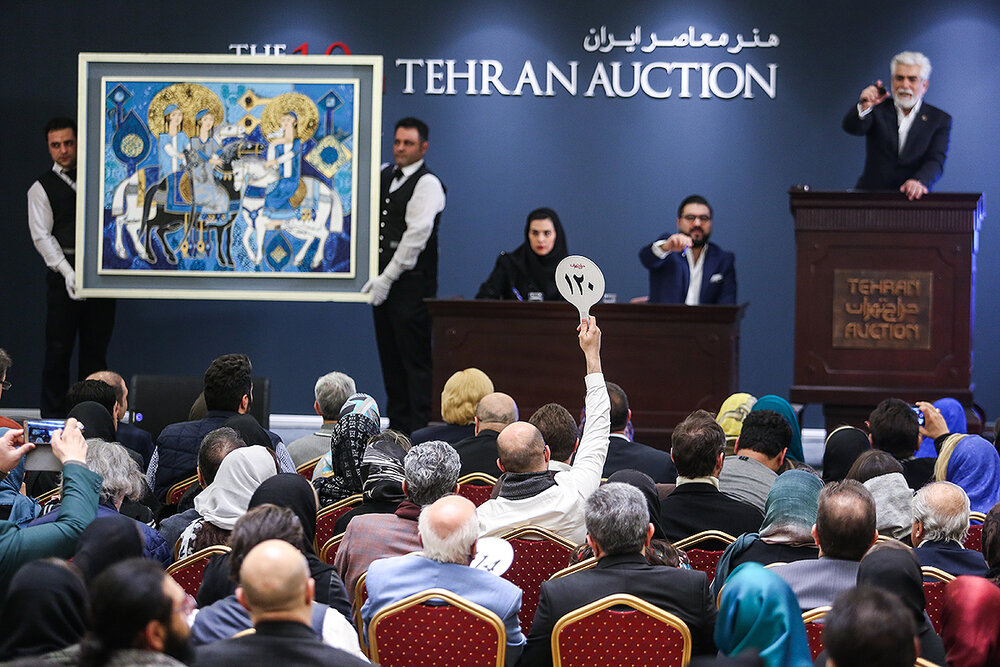Art exclusively for dealers’ benefit at auctions

TEHRAN – “Art for art’s sake” and “art for people’s sake” are phrases that have been expressed to describe the philosophy of art throughout different periods of history.
However, it appears that art auctions do not endorse any abovementioned ideas; instead, they exist exclusively for the sake of the dealers’ profits.
Auctions are generally a phenomenon in capitalist societies, where opportunities are distributed based on people’s financial worth. Consequently, at auctions, art is no longer for art’s sake, art is no longer for people’s sake, but art is at the dealers’ service.
The 13th edition of the Tehran Auction was organized last Friday, causing controversies over the sale of artwork by Iranian painter Aidin Aghdashlu who is facing allegations of sexual misconduct.
His “Memories of Hope”, a diptych gouache and colored pencil created on cardboard in 2020, was the most expensive work sold at the auction, fetching 120 billion rials (about $550,000 based on Iran’s free-market exchange rate: $1 = 221,000 rials).
Part of the controversies aroused over the authenticity of the artwork as people in social media accused Aghdashlu of copying “The Duke and Duchess of Urbino”, a diptych by the Italian painter of the Early Renaissance, Piero della Francesca.
Due to the allegations, highly critical comments have been made about the auction’s decision to select the work by Aghdashlu.
Some of the people have said that to respect public opinion, it would have been better that the auction had not selected any works by the artist for this year’s sale.
“Showcasing or offering an artwork from an artist during an exhibition or auction doesn’t imply a comment about the moral conduct of the artist; this is a rule all over the world,” Tehran Auction director Alireza Sami-Azar, who is also the founder of the auction, told the Persian service of Khabaronline.
He said that the Ministry of Culture and Islamic Guidance had earlier approved all the artworks offered at the auction.
“Beyond all the rumors and allegations, what we know about Mr. Aghdashlu is that no plaintiff has filed a lawsuit against him, but he has sued some people for defamation of character,” he noted.
Like any newly-established organization, the Tehran Auction has had shortcomings in its mission over the past nine years following its establishment.
It was set up by Sami-Azar, a former director of the Tehran Museum of Contemporary Art, “to introduce the best of Iranian art ranging from established and emerging Iranian artists to Iranian art collectors and the global audience.”
“It is an endeavor to fulfil the increasing interest in modern and contemporary Iranian art, and to facilitate the acquisition of the best quality works of various genres. It also aims to support the domestic art market as a key basis for the international market.”
However, some experts do not take a very positive view of the organization.
“The Tehran Auction throws the art market into disorder in one day, causing the artists to lose their true position,” Bahram Kalhornia, the director of the Vard Gallery in Tehran, told the Persian service of IRNA earlier in 2020.
“Unfortunately, overestimating artworks by a number of emerging artists at the auction resulted in a misunderstanding by the artists who, unconventionally, increased the price of their artworks after each sale of the Tehran Auction,” he added.
Kalhornia noted that the auction was not successful in its mission to introduce Iran’s premier art and said, “The auction has been planned only according to the interests of a certain minority, therefore, it can never turn into a national event that would include all Iranian artists.”
He added that the auction has privileged a certain group of artists, and this attitude has caused unreasonable competition among the gallery owners, who are unable to compete in a public market.
However, he viewed the auction as a matter of necessity, and said that the role of the auction in raising people’s awareness of artworks is undeniable.
He proposed that a national treasury for artworks should be set up under the supervision of a council of artists, collectors and other visual art activists to prevent any disorder in the auction.
Lili Golestan, director of Golestan Gallery in Tehran, also confirmed the misunderstanding by the emerging artists, and said the artists do not know the difference between an auction and an ordinary art showcase.
“Pricing at auctions cannot be considered as a criterion for the prices in the galleries’ market,” she noted and added, “The artists should realize that no miracle has occurred in the quality of their works in the aftermath an auction.”
The Tehran Auction has always been accused of colluding with galleries, artists and dealers to select and offer artworks. The challengers also allege that artists collude with dealers to sell their artworks at higher prices.
However, Golestan denied the accusations, “An expert team scrutinizes artworks, and due to their superior technical knowledge of the market, they choose the artworks that have a better chance to be sold.”
Sami-Azar had previously said that the Tehran Auction would exclude an artwork if the organizers discover any collusion between artists, dealers and collectors in the sales.
Photo: Auctioneer Hossein Pakdel (R) takes a bid for the sale of an artwork during the 10th Tehran Auction at the Parsian Azadi Hotel in Tehran on January 11, 2019. (ISNA/Kimia Nik)
MMS/YAW
